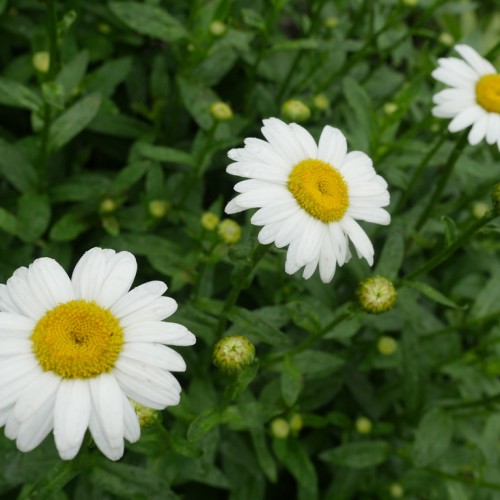
shasta daisy
Leucanthemum superbum
Cycle:
Herbaceous Perennial
Watering:
Minimum
Hardiness Zone:
5 - 9
Flowers:
Flowers
Sun:
Full sun
Leaf:
Yes
Growth Rate:
High
Maintenance:
Low
Drought Tolerant:
Yes
Salt Tolerant:
Yes
Care Level:
Medium
watering
Shasta daisy (Leucanthemum superbum) is a hardy plant that requires occasional watering to keep it healthy. The amount of water the plant needs depends on the amount of sun and wind the plant receives, as well as the soil and temperature conditions. In general, Shasta daisies prefer light watering during the morning or late afternoon. Water thoroughly until the top inch of soil has been moistened. Allow the soil to dry out slightly between waterings and avoid getting the leaves wet, as this can lead to fungal disease. Watering once a week should be sufficient during the summer months, but during hot or dry periods the plant may need to be watered twice a week. In the winter months, water less frequently, maybe once every 2 weeks.
sunlight
Shasta daisy (Leucanthemum superbum) prefers full sun in order to thrive. The plants prefer 6-8 hours of sun each day, which can be provided by a bright east- or south-facing window or by an outdoor location that has direct sun for most of the day. If the plants receive less than 6 hours of sun, they will not bloom as profusely, and the foliage may become sparse. When planting outdoors, choose an area that is not blocked by trees or other tall plants, and be sure to provide good air circulation.
pruning
Shasta daisies (Leucanthemum superbum) should be pruned twice annually for optimal growth and flowering. Pruning Shasta daisies should be done once in late fall or early winter, and once in late spring or early summer. When pruning in late fall or early winter, remove any foliage from the previous season to the ground, taking care not to disturb roots or buds. This will help stimulate healthy growth in the upcoming season. In late spring or early summer, prune Shasta daisies back to about 4" to 6" high. This will help keep the plants tidy and encourage new growth and blooming. Deadheading (removing spent blooms) during the blooming season can also help improve the plant's appearance, as well as helping to reduce the spread of disease.
